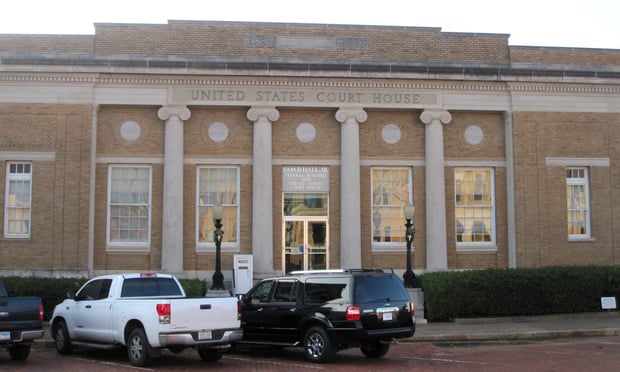Creative Plaintiffs Drive Rapid Evolution of Patent Venue Law
After the Supreme Court drastically altered patent venue law last year, plaintiffs are scrambling for ways to keep suing corporate defendants in perceived plaintiff-friendly forums, such as the Eastern District of Texas.
April 03, 2018 at 05:19 PM
6 minute read

After the Supreme Court drastically altered patent venue law last year, plaintiffs are scrambling for ways to keep suing corporate defendants in perceived plaintiff-friendly forums, such as the Eastern District of Texas.
After a quarter-century in which patent plaintiffs could sue a defendant anywhere it is subject to personal jurisdiction, the Supreme Court has narrowed the venue options for a corporate patent defendant to either the state of incorporation or “where the defendant has committed acts of infringement and has a regular and established place of business.” TC Heartland v. Kraft Foods Grp. Brands, 137 S. Ct. 1514, 1517 (2017). The Federal Circuit then clarified the requirements for where the defendant “has a regular and established place of business”: “(1) there must be a physical place in the district; (2) it must be a regular and established place of business; and (3) it must be the place of the defendant.” In re Cray, 871 F.3d 1355, 1362 (Fed. Cir. 2017). Because many corporate defendants do not have regular and established places of business in traditional hotbeds of patent suits (such as the Eastern District of Texas), district courts in recent months have transferred dozens of cases on these grounds.
To stem the tide, plaintiffs have marshaled a variety of creative arguments to try to keep their cases in their desired venues. Within the last few months, numerous plaintiffs have resisted transfer by arguing that venue is proper because a place of business of the defendant's corporate affiliate is, in fact, a “place of the defendant” (the third element of the Cray test). Those arguments rest largely on traditional notions of “alter ego” and lack of “separateness” between the two corporations. For the quarter-century before TC Heartland, the Federal Circuit's broader interpretation of patent venue had obviated the need for plaintiffs to make such arguments. The law here is not rapidly developing, and we see some trends emerging.
First, the corporate affiliate argument has some merit. Before the Federal Circuit broadened patent venue more than a quarter-century ago, it made clear that “venue in a patent infringement case [may be] proper with regard to one corporation by virtue of the acts of another, intimately connected, corporation.” Minn. Mining & Mfg. v. Eco Chems., 757 F.2d 1256, 1265 (Fed. Cir. 1985). One district court recently held that Cray “did not appear to disturb the holding in Minn. Mining,” West View Research v. BMW of N. Am., No. 16-cv-2590-JLS (S.D. Cal. Feb. 5, 2018). The decision has been revived in the post-Cray flurry of patent venue decisions: several district courts have cited Minn. Mining in deciding motions to transfer venue. E.g., Cooper Lighting v. Cordelia Lighting, No. 16-cv-2669-MHC (N.D. Ga. Jan. 25, 2018); UCB v. Mylan Techs., No. 17-cv-322-LPS (D. Del. Dec. 1, 2017).
Although numerous plaintiffs have recently advanced this corporate affiliate argument, none has yet succeeded. But at least two plaintiffs have managed to get a motion to transfer venue stayed pending further venue-related discovery authorized by the court, and those cases have not yet reached a final venue decision. Mallinckrodt IP v. B Braun Med., No. 17-cv-365-LPS (D. Del. Dec. 14, 2017); Javelin Pharm. v. Mylan Labs., No. 16-cv-224 (D. Del. Dec. 1, 2017). To obtain venue-related discovery, the plaintiff must establish that there is at least some possibility that formal corporate separateness was not preserved. Post Consumer Brands v. Gen. Mills, 2017 WL 4865936, at *2 (E.D. Mo. Oct. 27, 2017). Even mere failure by the defendant to affirmatively establish in the record that formal corporate separateness is preserved may be adequate for the plaintiff to get venue-related discovery. See Mallinckrodt IP; Javelin Pharm.
Some plaintiffs have looked beyond corporate affiliates, arguing that even a third-party distributor, one which unquestionably maintains formal corporate separateness from the defendant, could have its place of business imputed to the defendant for venue purposes. Cray does provide some support for this theory, indicating that a place of business may be “of the defendant” if the defendant “exercises attributes of possession or control over the place.” See 871 F.3d at 1363. This suggests that a lesser showing than affiliate “alter ego” proof may be accepted by courts to establish venue. Despite this statement in Cray, though, the argument has not yet succeeded. For example, in West View Research v. BMW of North America, the defendant did not have any place of business in the forum. There were, however, several dealerships in the forum which exclusively sold cars distributed by the defendant, and BMW allegedly exerted significant control over these dealerships. The court gave short shrift to plaintiff's theory of control, finding that the formal corporate separateness precluded the dealerships from being “places of the defendant.” Other courts have generally taken the same approach. E.g., Galderma Labs. v. Teva Pharm. USA, No. 17-cv-1076-M (N.D. Tex. Nov. 17, 2017); CAO Lighting v. Light Efficient Design, No. 16-cv-482-DCN (D. Idaho Oct. 11, 2017). There seems little doubt, however, that plaintiffs will continue to advance creative arguments that defendants exercise “attributes of possession or control” over physical places within the plaintiff's preferred venue, and the courts will need to flesh out the limits of Cray's test in this regard.
Practical Considerations
This emerging trend of establishing patent venue based on the presence of the defendant's corporate affiliate in the district yields several practical considerations for patent plaintiffs. First, prepare in advance to offer proof of lack of corporate “separateness” between your defendant and its affiliate. Consider identifying a corporate affiliate in your pleading as a basis for proper venue to enhance the credibility of this strategy with the court. And always ask for discovery of both the defendant and its affiliate; have your discovery ready to go when you file the case. Finally, within the bounds set by Fed. R. Civ. P. 11, consider suing the affiliate as well. Where there is a good-faith basis for believing that the affiliate may have some liability for the infringement, having the affiliate in the case should greatly strengthen the plaintiff's ability to obtain “separateness” discovery from the affiliate.
Kirt O'Neill is the partner in charge of Akin Gump Strauss Hauer & Feld's San Antonio office and a member of the firm's IP Steering Committee, specializing in patent and antitrust litigation. He is an honors graduate of the University of Texas School of Law and a life fellow of the San Antonio Bar Foundation.
Colin Phillips is an associate in Akin Gump's Houston office, and a recent graduate of the University of Houston Law Center. Before starting his legal career, he worked for Lockheed Martin as a communications and video systems engineer for Mission Control in the NASA Johnson Space Center.
This content has been archived. It is available through our partners, LexisNexis® and Bloomberg Law.
To view this content, please continue to their sites.
Not a Lexis Subscriber?
Subscribe Now
Not a Bloomberg Law Subscriber?
Subscribe Now
NOT FOR REPRINT
© 2025 ALM Global, LLC, All Rights Reserved. Request academic re-use from www.copyright.com. All other uses, submit a request to [email protected]. For more information visit Asset & Logo Licensing.
You Might Like
View All

Nondisparagement Clauses in Divorce: Balancing Family Harmony and Free Speech
6 minute read

Trending Stories
- 1Lawyers: Meet Your New Partner
- 2What Will It Mean in California if New Federal Anti-SLAPP Legislation Passes?
- 3Longtime AOC Director Glenn Grant to Step Down, Assignment Judge to Take Over
- 4Elon Musk’s Tesla Pay Case Stokes Chatter Between Lawyers and Clients
- 5Courts Demonstrate Growing Willingness to Sanction Courtroom Misuse of AI
Who Got The Work
J. Brugh Lower of Gibbons has entered an appearance for industrial equipment supplier Devco Corporation in a pending trademark infringement lawsuit. The suit, accusing the defendant of selling knock-off Graco products, was filed Dec. 18 in New Jersey District Court by Rivkin Radler on behalf of Graco Inc. and Graco Minnesota. The case, assigned to U.S. District Judge Zahid N. Quraishi, is 3:24-cv-11294, Graco Inc. et al v. Devco Corporation.
Who Got The Work
Rebecca Maller-Stein and Kent A. Yalowitz of Arnold & Porter Kaye Scholer have entered their appearances for Hanaco Venture Capital and its executives, Lior Prosor and David Frankel, in a pending securities lawsuit. The action, filed on Dec. 24 in New York Southern District Court by Zell, Aron & Co. on behalf of Goldeneye Advisors, accuses the defendants of negligently and fraudulently managing the plaintiff's $1 million investment. The case, assigned to U.S. District Judge Vernon S. Broderick, is 1:24-cv-09918, Goldeneye Advisors, LLC v. Hanaco Venture Capital, Ltd. et al.
Who Got The Work
Attorneys from A&O Shearman has stepped in as defense counsel for Toronto-Dominion Bank and other defendants in a pending securities class action. The suit, filed Dec. 11 in New York Southern District Court by Bleichmar Fonti & Auld, accuses the defendants of concealing the bank's 'pervasive' deficiencies in regards to its compliance with the Bank Secrecy Act and the quality of its anti-money laundering controls. The case, assigned to U.S. District Judge Arun Subramanian, is 1:24-cv-09445, Gonzalez v. The Toronto-Dominion Bank et al.
Who Got The Work
Crown Castle International, a Pennsylvania company providing shared communications infrastructure, has turned to Luke D. Wolf of Gordon Rees Scully Mansukhani to fend off a pending breach-of-contract lawsuit. The court action, filed Nov. 25 in Michigan Eastern District Court by Hooper Hathaway PC on behalf of The Town Residences LLC, accuses Crown Castle of failing to transfer approximately $30,000 in utility payments from T-Mobile in breach of a roof-top lease and assignment agreement. The case, assigned to U.S. District Judge Susan K. Declercq, is 2:24-cv-13131, The Town Residences LLC v. T-Mobile US, Inc. et al.
Who Got The Work
Wilfred P. Coronato and Daniel M. Schwartz of McCarter & English have stepped in as defense counsel to Electrolux Home Products Inc. in a pending product liability lawsuit. The court action, filed Nov. 26 in New York Eastern District Court by Poulos Lopiccolo PC and Nagel Rice LLP on behalf of David Stern, alleges that the defendant's refrigerators’ drawers and shelving repeatedly break and fall apart within months after purchase. The case, assigned to U.S. District Judge Joan M. Azrack, is 2:24-cv-08204, Stern v. Electrolux Home Products, Inc.
Featured Firms
Law Offices of Gary Martin Hays & Associates, P.C.
(470) 294-1674
Law Offices of Mark E. Salomone
(857) 444-6468
Smith & Hassler
(713) 739-1250






